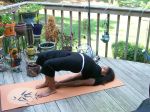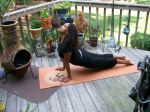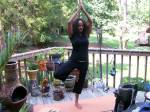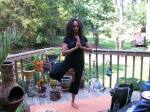
Easy Pose
Balance In Your Home Yoga Practice
by Trina
We tend to do more of what we like and less of what we don’t like. This practice also bleeds over into our home exercise practices, but we must learn to balance even when our instructor isn’t around to remind us or to choreograph our routine.
Yoga teaches that balance is extremely vital to the practice and our bodies. When we inhale, our exhale should be the length of our inhale. When we work our right side, we must work the left side. Every muscle that we contract, we must lengthen or stretch. In Yoga, each pose has a counter pose to create the necessary balance.
I want to emphasize the importance of balance in your home routine, specifically when you work your abdominal (abs) muscles. Everyone wants great abs, so people tend to do extensive abdominal exercises, especially at home, where people are enamored with sit ups and crunches. But as you strengthen your abs, you must also stretch out the ab muscle that you worked AND strengthen and loosen your lower back. The abs and the lower back work together to provide strength and stability and to support vital organs and stabilize the skeleton.
Have you ever seen those body builders whose arms are so huge and thick that their shoulders round over? That is an example of imbalance. We are inclined to develop the muscles and body parts that we can see, the front of our body, often neglecting what we don’t see, the back of our body.
In your home practice, I encourage you to do more than crunches and sit ups. Try some of the poses listed below that not only work your abs, but they also work your Core. When you work your abs, include poses that loosen, stretch, and strengthen your lower back too. Essentially, you want to make sure that when you work or contract a muscle, you also lengthen and stretch it, for example, after Bridge Pose (contracting the back and stretching the abs) do Plow Pose (stretching the back and contracting the abs).

Bridge Pose
*After Bridge Pose, do Plow Pose
Camel Pose prepares the body for more difficult Backbend Poses. It makes the lower back flexible, while limbering the shoulders and opening the chest. Child’s Pose is an excellent counter pose to Camel.

Locust Pose
Locust Pose strengthens the lower back muscles, while opening the chest, and encouraging good breathing. A good counter pose to Locust is to lie on your back and hug your knees to your chest.
Bow Pose induces flexibility in the spine, tones the abdominal muscles, and also helps to relieve backaches. Child’s Pose is a good counter pose.
Balancing Poses, such as Tree Pose and Chair Pose, also strengthen your abs and your lower back.

Upward Facing Dog
The Sun Salutations series contracts the abs when you are in forward bends, such as Standing Forward Bend, and it lengthens the abs in back bends, such as Upward Facing Dog.
Here are Core Poses that loosen, stretch, and strengthen your Core muscles:
Full Boat Pose
The Hundred
Dolphin
Plank
Bridge Pose
Staff Pose
Dolphin Plank Pose
Upward Plank Pose
Resources:
The Yoga Bible by Christina Brown
The Yoga Journal
About.com
Althea Lawton-Thompson of Aerobics Yoga & More
*Disclaimer: As with any exercise regimen, consult your doctor or physician before you start. Make sure that you have adequate instructions about how to do these poses before you do them. Leisure Living, it’s contributors, or listed resources are not responsible for any injuries.
© 2009 KaTrina Love


 In this Yoga Basics series, we discussed how important it is to
In this Yoga Basics series, we discussed how important it is to 
 Writing and Yoga
Writing and Yoga
 coaxing confidence. I can focus on one thought at a time, I’m peaceful and calm, and my mind is lucid. I accept where I am at the moment and embrace my limitations. I am patient with myself. This focusing, balance, acceptance, and patience blankets me as I sit at my keyboard and escape into my plot, allowing my characters to live and breath through my fingers.
coaxing confidence. I can focus on one thought at a time, I’m peaceful and calm, and my mind is lucid. I accept where I am at the moment and embrace my limitations. I am patient with myself. This focusing, balance, acceptance, and patience blankets me as I sit at my keyboard and escape into my plot, allowing my characters to live and breath through my fingers.